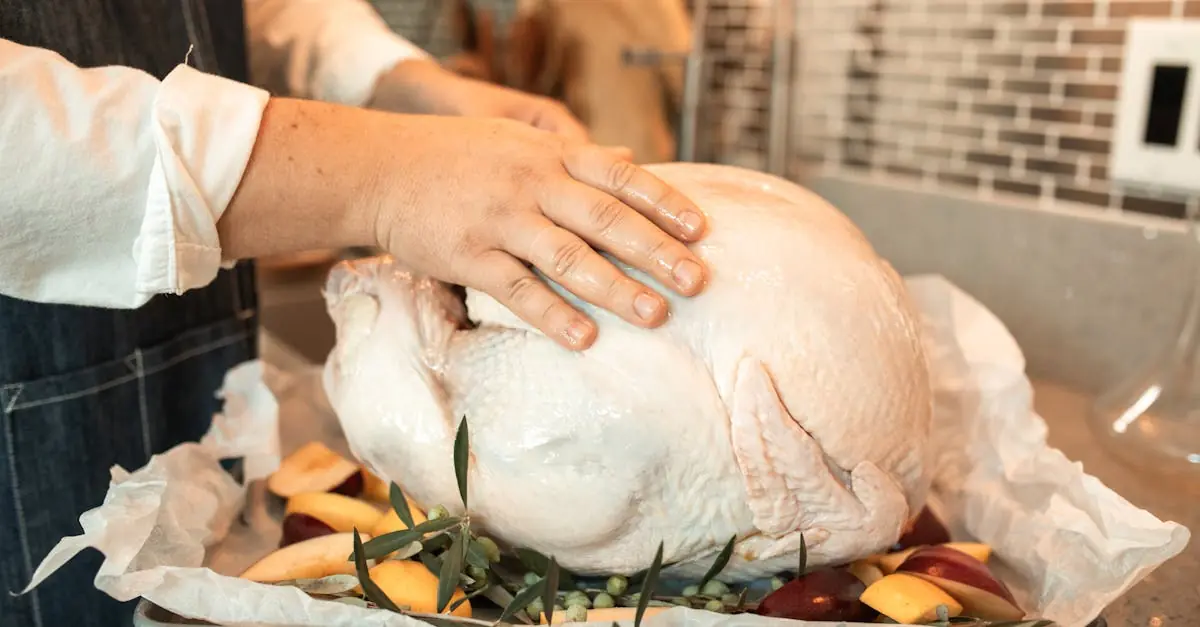Roast chicken prep is like a culinary rite of passage. It’s the moment when home cooks transform a humble bird into a mouthwatering masterpiece that could make even the most seasoned chefs jealous. With just a few simple steps, anyone can elevate their dinner game from “meh” to “magnificent.”
Imagine the aroma wafting through your kitchen as that golden skin crisps up, making your neighbors question their life choices. Whether it’s a cozy family dinner or an impressive gathering, mastering the art of roast chicken prep is a skill worth having. So roll up those sleeves and get ready to unleash your inner chef—because who doesn’t want to be the star of their own dinner party?
Table of Contents
ToggleUnderstanding Roast Chicken Prep
Roast chicken prep is a critical aspect of cooking that significantly influences the dish’s final flavor and texture. Mastering this prep enhances one’s culinary repertoire.
Importance of Proper Preparation
Proper preparation sets the stage for success. Ensuring the chicken is clean and patted dry promotes even cooking. Seasoning the bird generously with salt and herbs allows flavors to penetrate deeply, enhancing the taste. Also, using a room-temperature chicken contributes to more uniform cooking results. Taking time to marinate can add richness to the dish, making every bite enjoyable. Attention to detail during this stage can lead to a perfectly roasted chicken that impresses guests.
Different Methods of Prep
Several methods exist to prepare roast chicken effectively. Brining involves soaking the chicken in a saltwater solution, ensuring moisture retention. Dry brining, in contrast, uses salt applied directly to the skin, encouraging crispiness. Spatchcocking, or removing the backbone, allows for faster cooking and a flatter, more even roast. Marinades can infuse the chicken with various flavors, ranging from citrus to spicy. Choosing the right method depends on desired taste and available time, with each method offering unique benefits that enhance the overall roast chicken experience.
Choosing the Right Chicken
Selecting the right chicken impacts the roast’s flavor and texture. Various factors play a role in making the best choice.
Organic vs. Conventional
Organic chicken often comes with a higher price tag. It tends to feature a more natural diet and avoids antibiotic use, leading to potential flavor differences. Conventional chicken, on the other hand, is typically more affordable. Many consumers appreciate its availability, but it may contain added hormones and antibiotics. Taste tests reveal varying opinions about flavor, with some preferring the richer, deeper taste of organic varieties. Ultimately, the choice between organic and conventional depends on personal preferences and dietary considerations.
Size and Weight Considerations
Weight significantly affects cooking time and flavor. Whole chickens typically weigh between 3 and 6 pounds, with smaller birds often yielding higher moisture levels. Larger chickens can provide more meat, suitable for bigger gatherings. A 4 to 5-pound chicken usually cooks well in about 1.5 to 2 hours at a temperature of 375°F. Selecting the right size ensures even cooking and optimal results. Assessing the number of servings needed allows for better decision-making when choosing a chicken size.
Essential Ingredients for Flavor
Flavorful roast chicken relies heavily on key ingredients that elevate its taste. Selecting the right elements ensures that the dish becomes a memorable centerpiece.
Herbs and Spices
Fresh herbs and aromatic spices influence the chicken’s final flavor profile. Rosemary, thyme, and parsley enhance the dish with earthy notes. Paprika and garlic powder add a savory kick that complements the meat. Choosing a mix of dried or fresh ingredients can create a harmonious blend. It’s beneficial to experiment with ratios to personalize the flavor, adjusting according to preferences. Applying seasoning under the skin elevates the taste, allowing it to infuse during cooking.
Marinades and Rubs
Marinades and dry rubs serve as flavor powerhouses. A simple marinade of olive oil, lemon juice, and garlic penetrates the meat and tenderizes it. Adding Dijon mustard or honey can introduce contrasting flavors that excite the palate. Dry rubs composed of sugar, salt, and various spices create a crispy crust, enhancing texture. Applying these mixtures several hours before roasting maximizes flavor absorption. Personalizing these combinations allows for unique and exciting results, transforming a basic roast chicken into an unforgettable meal.
Step-by-Step Roast Chicken Prep
Proper roast chicken preparation leads to a flavorful and satisfying meal. Follow these steps for the best results.
Cleaning and Trimming the Chicken
Start by removing the chicken from its packaging. Fresh chicken contains bacteria; rinsing under cold water isn’t necessary and may spread germs. Instead, check inside the cavity for any giblets and remove them. Next, trim excess fat and any loose skin for even cooking. Pat the chicken dry with paper towels to promote crisp skin and better browning during roasting. Keeping the chicken clean and properly trimmed plays a critical role in achieving successful cooking.
Seasoning Techniques
Seasoning enhances the chicken’s flavor significantly. Generously apply kosher salt and freshly ground black pepper to the inside and outside for the best taste. Herb blends, like rosemary and thyme, and spices, such as garlic powder and paprika, elevate the flavor profile. For extra depth, consider creating a marinade or dry rub, which adds moisture and complexity. Allowing the seasoned bird to rest for at least 30 minutes permits the flavors to permeate, ensuring a mouthwatering roast.
Cooking Techniques for Perfect Roast Chicken
Multiple cooking techniques contribute to achieving the perfect roast chicken. Methods vary, and each brings unique flavors and textures to the dish.
Oven Roasting
Oven roasting remains a popular choice for preparing roast chicken. Preheating the oven to 425°F ensures a crispy skin while retaining moisture in the meat. Placing the chicken on a rack promotes air circulation, allowing even cooking. Using a probe thermometer helps monitor the internal temperature, which should reach 165°F for safety. Basting with pan juices every 20 minutes adds flavor and keeps the chicken juicy. Resting the chicken for 15-20 minutes before carving allows the juices to redistribute, enhancing the overall taste.
Alternative Methods
Various alternative methods can elevate the roast chicken experience. Grilling introduces a smoky flavor, especially when using a charcoal grill. Rotisserie cooking provides even heat, ensuring a tender, succulent result. Slow roasting at a lower temperature, around 325°F, can create fall-off-the-bone tenderness. Sous vide is another option, allowing precise temperature control for consistent results. These methods offer flexibility and creativity in achieving that perfect roast chicken, tailored to individual preferences.
Mastering roast chicken prep opens up a world of culinary possibilities. With the right techniques and attention to detail anyone can transform a simple chicken into a centerpiece that delights the palate. The aroma of a perfectly roasted chicken creates an inviting atmosphere that enhances any gathering.
By selecting quality ingredients and experimenting with various preparation methods home cooks can personalize their roast chicken experience. Whether it’s through brining or using fresh herbs each step contributes to a memorable meal.
As they embrace this skill in the kitchen they’ll find that roast chicken is not just a dish but a celebration of flavor and creativity.




